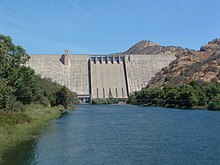Pine Flat Dam
| Pine Flat Dam | |
|---|---|
 |
|
| Country | United States |
| Location | Fresno County, California |
| Coordinates | 36°49′56″N 119°19′34″W / 36.83222°N 119.32611°WCoordinates: 36°49′56″N 119°19′34″W / 36.83222°N 119.32611°W |
| Construction began | 1947 |
| Opening date | 1954 |
| Dam and spillways | |
| Type of dam | Concrete gravity |
| Impounds | Kings River |
| Height | 440 ft (130 m) |
| Length | 1,840 ft (560 m) |
| Reservoir | |
| Creates | Pine Flat Lake |
| Total capacity | 1,000,000 acre·ft (1.2 km3) |
| Inactive capacity | 45,379 acre·ft (0.055974 km3) |
| Catchment area | 1,545 sq mi (4,000 km2) |
| Surface area | 5,970 acres (2,420 ha) |
| Normal elevation | 955 ft (291 m) (max) |
| Power station | |
| Hydraulic head | 424 ft (129 m) |
| Turbines | 3x 55MW Francis |
| Installed capacity | 165 MW |
| Annual generation | 420,000,000 KWh |
Pine Flat Dam is a concrete gravity dam on the Kings River of central California in the United States. Situated about 20 miles (32 km) east of Fresno, the dam is 440 feet (130 m) high and impounds Pine Flat Lake, one of the largest reservoirs in California, in the foothills of the Sierra Nevada just outside the boundary of Kings Canyon National Park. The dam's primary purpose is flood control, with irrigation, power generation and recreation secondary in importance.
The dam was built by the U.S. Army Corps of Engineers (USACE) after a six-year controversy between supporters of irrigation development and proponents of flood control. Construction began in 1947 and was completed in 1954. Since then, the dam has prevented millions of dollars in flood damages and fostered extensive development of agriculture on the fertile floodplain of the Kings River; after 1984 it has also generated hydroelectricity. However, the increased irrigation allowed by the dam has also led to the destruction of some of North America's most extensive wetland habitats.
The first serious proposal to dam the Kings River was made in the 1850s by engineer J.B. Lippincott, who surveyed and envisioned the development of a 185,000-acre-foot (0.228 km3) reservoir on the river. However, it was not until 1914 when the proposed Kings River dam gained strong support from area farmers and water districts, who formed the Kings River Water Association (KRWA) in 1927 to allocate river water for the irrigation of 958,000 acres (388,000 ha) of the San Joaquin Valley on the alluvial plain of the Kings River. In 1937, the KRWA appealed to the federal government to provide financial aid and support the construction of a large dam at Pine Flat.
Starting in 1938, two government agencies – the USACE and the U.S. Bureau of Reclamation (USBR) – fought it out for the construction of Pine Flat Dam. With the support of President Franklin D. Roosevelt, the USBR wanted to incorporate the dam as part of its fledgling Central Valley Project (CVP), which intended to develop the rivers of the Central Valley for irrigation. The USACE objected to the bureau's plans, mainly because the primary purpose of the dam would be flood control. Some area farmers were also against the integration of Pine Flat Dam into the CVP, as under "reclamation law" individual farmers could not receive more water than was necessary for the irrigation of 160 acres (65 ha). All of the water in the Kings River was already appropriated to local irrigators, many of whom owned more land than the USBR limit.
...
Wikipedia
